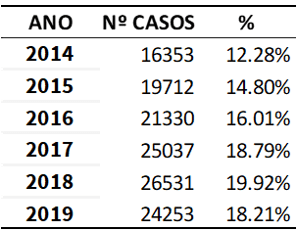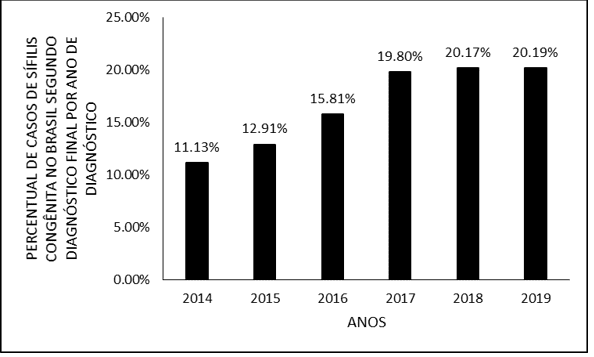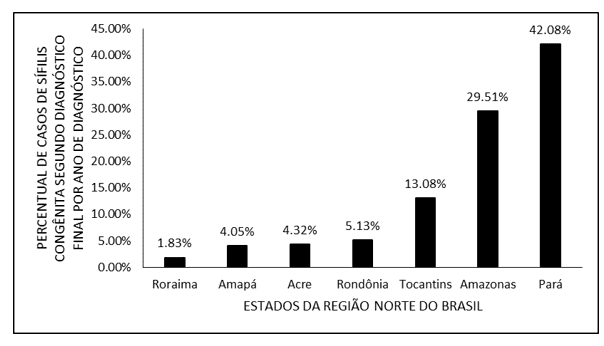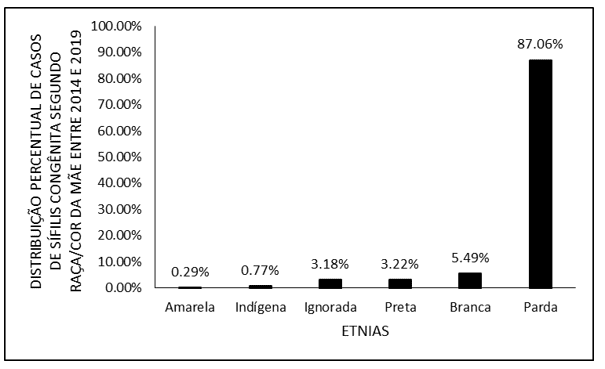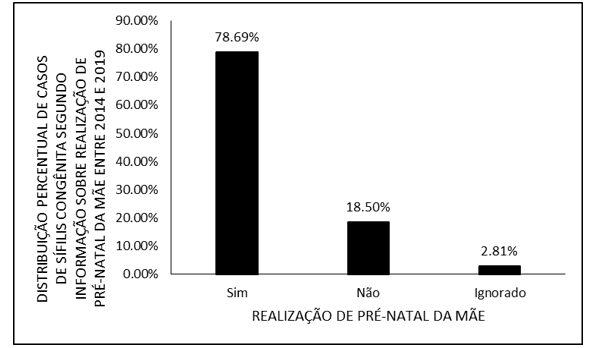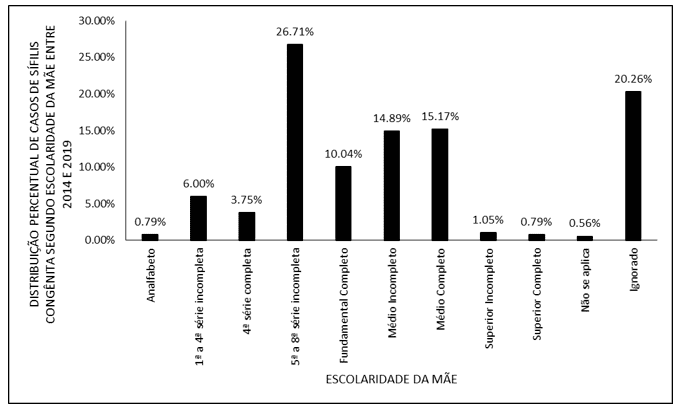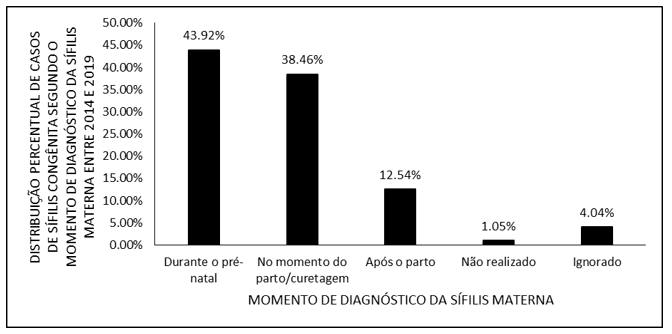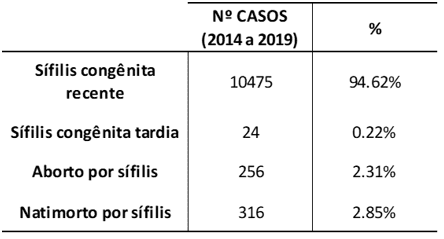ORIGINAL ARTICLE
ALMEIDA, Carolina Gomes [1], ÁVILA, Gabriel Pereira [2], TEIXEIRA, Isabelly Montenegro [3], RODRIGUES, Raíza Júlia Viana [4], DIAS, Claudio Alberto Gellis de Mattos [5], OLIVEIRA, Euzébio de [6], DENDASCK, Carla Viana [7], ARAÚJO, Maria Helena Mendonça de [8], FECURY, Amanda Alves [9]
ALMEIDA, Carolina Gomes. Et al. Epidemiological characterization of cases of Congenital Syphilis in northern Brazil, from 2014 to 2019. Revista Científica Multidisciplinar Núcleo do Conhecimento. Year 05, Ed. 12, Vol. 14, pp. 20-31. December 2020. ISSN: 2448-0959, Access link: https://www.nucleodoconhecimento.com.br/health/northern-brazil, DOI: 10.32749/nucleodoconhecimento.com.br/health/northern-brazil
SUMMARY
Syphilis is a disease caused by the bacterium Treponema pallidum, acquired, in large part, by sexual transmission. Congenital syphilis is a contagious disease of vertical transmission (from mother to fetus). This study aimed to present the number of reported cases of congenital syphilis in northern Brazil, between 2014 and 2019, and to characterize the epidemiological profile of the cases. Descriptive, cross-sectional and retrospective research was carried out using DATASUS database. There was an increase in the number of cases in the period evaluated, especially the State of Amazonas, which presented the highest number of notifications. Regarding prenatal care, an average of four times more women perform than those who did not. Women with maternal school grade from the 5th to 8th incomplete elementary school had a higher number of cases of the disease. Although the northern region had a high prenatal performance, most cases of congenital syphilis were diagnosed only after delivery, indicating erroneous interpretations regarding the tests and consequent error in diagnosis and treatment. Since the early form (emergence until the 2nd year of life) is the majority of the number of cases, there is a favorable evolution of the disease.Schooling and income seem to be factors that influence the late diagnosis of the disease. There is a need for increased treated partners, reducing the transmission of syphilis and, consequently, congenital syphilis.
Keywords: Congenital syphilis, Northern Region, Prenatal.
INTRODUCTION
Syphilis is a systemic, chronic, curable and exclusive bacterial infection of the human being. When left untreated, it evolves to stages of varying severity, and may affect organs and systems of the body (BRASIL, 2018). The causative agent of syphilis is the bacterium Treponema pallidum, a spirochete, acquired in most cases during sexual intercourse. The disease is classified, according to its different routes of transmission, in acquired syphilis and congenital syphilis (CAVALCANTE et al., 2012, ROCHA et al., 2020).
Congenital syphilis is the result of hematogenous spread of T. pallidum, of the infected pregnant woman who is untreated or inadequately treated for her conceptus, transplacentally (CRT, 2016). Transmission may occur throughout pregnancy, and the risk is higher in pregnant women with primary or secondary syphilis (GUINSBURG; SANTOS, 2010, BARROS et al., 2020).
It is a disease responsible for approximately 40% of perinatal mortality rates, 25% of stillbirth, 14% of neonatal deaths (CARDOSO et al., 2018). In addition, it is capable of entailing serious consequences for the conceptus as systemic complications, whether in early congenital syphilis (bone, neurological, hematological and hepatosplenic involvement), or late (stigmas arising from remodeling and bone deformities) (MOTTA et al., 2018).
The effective control of syphilis has as its fundamental premise serological screening and the appropriate treatment of pregnant women and sexual partners, since the quality of prenatal care and childbirth is an important determinant in reducing vertical transmission. Penicillin is the drug of choice in the treatment of syphilis and the only one indicated for pregnant women: it has 98% efficacy in the prevention of congenital syphilis, acting at all stages of the disease (CAVALCANTE; PEREIRA, CASTRO, 2017).
GOAL
Present the number of reported cases of congenital syphilis in northern Brazil, between 2014 and 2019, and characterize the epidemiological profile of the cases.
METHOD
A descriptive, cross-sectional and retrospective quantitative study was conducted through data from the Notifiable Diseases Information System (SINAN/SUS) of the Informatics Department of the Unified Health System (DATASUS). National data were collected according to the following steps: The http://indicadoressifilis.aids.gov.br link was accessed and in “Data coverage” “Regional and national data” were selected and in “Subcategory” “Brazil”. The “Download Data” button was clicked and data regarding congenital syphilis Brazil was removed. Subsequently in “Data Coverage” “State Data” was selected and in “Subcategory” we selected the name of each state of the northern region of Brazil, the tables of each state were downloaded and the information to congenital syphilis was removed. The data was compiled within the Excel application,a component of the Microsoft Corporation Office suite.
RESULTS
The percentage of cases of congenital syphilis according to final diagnosis per year of diagnosis in Brazil between 2014 and 2019 is shown in Table 1. There was an increase in the percentage of cases from 12.28% in 2014 to 18.21% in 2019.
Table 1 – Shows the percentage of cases of congenital syphilis according to final diagnosis per year of diagnosis, in northern Brazil, between 2014 and 2019.
In northern Brazil, the percentage of cases of congenital syphilis according to final diagnosis per year of diagnosis between 2014 and 2019 was 11,071. In the period, there was an increase in the number of cases, from 11.13% in 2014 to 20.19% in 2019 (Figure 1).
Figure 1 – Shows the percentage of cases of congenital syphilis according to final diagnosis per year of diagnosis, in northern Brazil, between 2014 and 2019.
Among the states in the North region, Pará stood out with the highest number of cases (42.08%) and the one with the lowest amount, the state of Roraima (1.83%). (Figure 2).
Figure 2 – Shows the percentage of cases of congenital syphilis according to final diagnosis per year of diagnosis, by state in the North region of Brazil, between 2014 and 2019.
Figure 3 shows the percentage distribution of cases of congenital syphilis in the North region by second race/color (ethnicity) between 2014 and 2019. The data indicate a higher number of cases in the brown ethnic group with 9,638 (87.06%), followed by white with 608 (5.49%). The ethnic groups with the lowest number were indigenous with 85 (0.77%) and black with 32 (0.29%), respectively.
Figure 3 – Shows the percentage distribution of cases of congenital syphilis in the North region by second race/color (ethnicity) between the years 2014 and 2019.
Figure 4 shows the number of confirmed cases of congenital syphilis in the North region by prenatal examination between 2014 and 2019. The data show a greater number of women who underwent prenatal care 8,712 (78.69%) than those who did not undergo 2,048 (18.50%) and those considered ignored totaled 311 (2.81%).
Figure 4 – shows the percentage distribution of cases of congenital syphilis according to information on prenatal care of the mother per year of diagnosis between 2014 and 2019.
Figure 5 shows the percentage distribution of cases of congenital syphilis in the North region, according to the mother’s schooling per year of diagnosis between 2014 and 2019. The data show an important number of illiterate mothers of 62 women (0.90%), the majority of cases with the maternal school grade of the 5th to 8th incomplete elementary school with 2,362 (33.80%), with a collection of women having completed elementary school of 936 (13.40%) and a part completed high school 1,320 (18.90%), the lowest number of mothers with complete higher education was 62 (0.90%) and the number of ignored mothers were 2,243 (32.10%).
Figure 5 – Shows the percentage distribution of cases of congenital syphilis in the North region, according to the mother’s schooling per year of diagnosis between 2014 and 2019.
Figure 6 shows the number of confirmed cases of congenital syphilis in the North region at the time of maternal diagnosis for syphilis, between 2014 and 2019. There is a greater number of infections during prenatal examination with a total number of cases of 4,862 (43.92%) and also at the time of delivery with 4,258 (39.46%), with a minority of cases diagnosed in the postpartum period, with a total of 1,388 (12.54%) and those ignored totaled 447 (4.04%).
Figure 6 – Shows the percentage distribution of confirmed cases of congenital syphilis according to the moment of diagnosis in the North region, between the years 2014 and 2019.
Regarding the variable final classification of congenital syphilis, the data found were 10,475 (94.62%) classified as recent congenital syphilis; 24 classified as late congenital syphilis (0.22%); 256 (2.31%) abortions due to syphilis; and 316 (2.85%) stillborn by syphilis (Table 2).
Table 2 – Shows the percentage distribution of cases of congenital syphilis according to final diagnosis per year of diagnosis, in the Northern region of Brazil, between 2014 and 2019.
DISCUSSION
There was an increase in the number of cases from 2014 to 2019 (figure 1), especially the State of Amazonas, which increased by 416% (figure 2) the records of notification of the disease in the observed period, even being the State of the Northern Region with the highest GDP per capita (IBGE, 2016). This analysis of the relationship between the incidence of the disease and the economic capacity of the site is made by the fact that congenital syphilis is a relatively easy diagnostic disease and is totally preventable when the treatment of pregnant women and the partner is performed adequately (ARAUJO et al., 2006), which makes its prevalence generally related to a deficient economic power to provide a quality Basic Health, more specifically, to offer an effective Prenatal care for the population (ARAUJO et al., 2006).
However, underdevelopment would not explain alone the cause of Amazonas being the main growing state of the disease in the period observed, because compared to other states in the Northern Region, it is the best GDP, so the improvement in the notification of the disease in the State, could explain the fact that the Northern Region has a high prevalence of this comorbidity. In 2016, the Amazonas Health Department began a decentralization campaign for rapid testing for sexually transmitted diseases, previously superconcentrated in FMT (Heitor Vieira Dourado Tropical Medicine Foundation), redistributing them to the four SAEs (Specialized Care Services) of the city (BRASIL, 2016).
Still on the perspectives that seek to explain the high incidence of congenital syphilis in the North region, underdevelopment is also related to a population with a lower level of awareness, that is, it would not be enough only the availability of prenatal care, but the understanding of society about the importance of its realization, which helps to understand why it is a public health problem still so present in the Northern Region of Brazil, the second Brazilian region with the lowest GDP per capita, second only to the Northeast (IBGE, 2016).
Regarding the variable ethnicity in the recorded cases of congenital syphilis (figure 3), more than 90% of the cases were of mixed ethnicity (race) which is also the most prevalent ethnicgroup in the Northern Region, representing 66.88% of the population of this region of Brazil (IBGE, 2010).
It is also important to draw a parallel with two data collected in the research, the percentage of infected mothers who underwent prenatal care is more than 70% in the observed period (2014-2019) (figure 4), that is, most women in the region do this follow-up, which should imply a lower incidence of the disease. On the other hand, the number of untreated partners is high. Syphilis is a disease of sexual transmission, where it is mandatory the treatment of the partner. This reflects a difficult reality of Brazil in performing an effective prenatal care, the lack of satisfactory follow-up of the partner in consultations. One of the main problems that still exists in the control of sexually transmitted infections (STIs) during pregnancy is the partner’s approach (DUARTE, 2007). In addition, the problems arise with the notification and continue in an attempt to convince them of the need for diagnosis and treatment adhering (DUARTE, 2007).
Another factor is the level of illiteracy, only 0.9% were illiterate and the highest percentage is of people who completed at least elementary school (Figure 5). However, about 8% of the population in northern Brazil is illiterate, the second worst region, second only to the Northeast Region (IBGE, 2019). This comparison of data leads to questions about underreporting, whether the highest percentage of women with syphilis in the region actually have higher education or if the percentage that seeks care and has the reported cases is the majority instructed and the one with the lowest education follows without seeking care and does not have the disease reported.
Inadequate prenatal care prevents routine for diagnosis and effective and early treatment (ARAUJO et al, 2006). Data on the time of diagnosis reinforce the importance of effective prenatal care to combat the incidence of congenital syphilis, since the majority had the diagnosis at delivery or at the time of curettage (Figure 6).
CONCLUSION
Due to the high incidence of cases of Congenital Syphilis, there is the prominence of the North region to the detriment of other Brazilian regions. The underdevelopment of the region is a fundamental factor for explaining this fact, when there is a deficit in the public sectors, especially in education and health, the evidence is reflected in the population. In relation to Congenital Syphilis, most pregnant women had a low level of education, given this data, inview of a lack of information about the importance of prenatal care, both due to the lack of interest of the population and the little dissemination of the public health system. As an example, the state of Amazonas, which was the state with the highest percentage rate of cases reported in the period analyzed because of a greater performance in the screening of sexually transmitted infections, however, the greater availability of screening methods, exclusively, is not synonymous with an improvement in the incidence of cases of Congenital Syphilis.
Furthermore, the number of untreated partners has great relevance, since the most common route of transmission of syphilis is the sexual route. There is a lack of information and resistance by most of them. Thus, there is a need for the pregnant woman together with her partner to be screened during prenatal care to avoid possible reinfection of a treated patient or early diagnosis.
Therefore, it is observed that for the reduction of the incidence of cases of Congenital Syphilis, a range of factors are necessary, from the greater availability of information on the importance of prenatal care and its continuity by pregnant women and their partners. Therefore, cover early diagnosis and treatment, in order to avoid complications for the fetus or neonate.
REFERENCES
ARAUJO, Eliete da Cunha; Costa, Kelly de Souza Gama; SOUZA E SILVA, Rafaela; AZEVEDO, Valéria Nascimento; Lima, Fábio André Souto. Importância do pré-natal na prevenção da Sífilis Congênita. Revista Paraense de Medicina, Belém, v. 20, n. 1, p. 47-51, mar. 2006. Disponível em: http://scielo.iec.gov.br/scielo.php?script=sci_arttext&pid=S0101-59072006000100008&lng=pt&nrm=iso Acesso em: 24 maio 2019.
BARROS, Yara Lorrane Souza de. Et al. Numbers of confirmed syphilis cases in pregnant women in Brazil between 2009 and 2013. Revista Científica Multidisciplinar Núcleo do Conhecimento. Year 05, Ed. 11, Vol. 25, pp. 53-61. November 2020. ISSN:2448-0959, Access link in: https://www.nucleodoconhecimento.com.br/health/syphilis-cases, DOI: 10.32749/nucleodoconhecimento.com.br/health/syphilis-cases
BRASIL, Ministério da Saúde. Departamento de Doenças de Condições Crônicas e Infecções Sexualmente Transmissíveis: Manaus recebe apoio da ONG AHF para descentralizar o atendimento de HIV/aids. 2016. Disponível em: http://www.aids.gov.br/pt br/noticias/manaus-recebe-apoio-da-ong-ahf-para-descentralizar-o-atendimento-de-hivaids Acesso em: 23 maio 2019.
BRASIL, Ministério da Saúde. Departamento de Vigilância, Prevenção e Controle das Infecções Sexualmente Transmissíveis, do HIV/Aids e das Hepatites Virais: Protocolo Clínico e Diretrizes Terapêuticas para Atenção Integral às Pessoas com Infecções Sexualmente Transmissíveis (IST). 2018. Disponível em: http://conitec.gov.br/images/Artigos_Publicacoes/Diretrizes/PCDT_Atencao_Integral_ IST_22-10-18.pdf Acesso em: 23 maio 2019.
CARDOSO, Ana Rita Paulo; ARAÚJO, Maria Alix Leite; CAVALCANTE, Maria do Socorro; FROTA, Mirna Albuquerque; DE MELO, Simone Paes. Análise dos casos de sífilis gestacional e congênita nos anos de 2008 a 2010 em Fortaleza, Ceará, Brasil. Ciência & Saúde Coletiva. v. 23, n. 2, p. 563-574, 2018. Disponível em: https://www.scielosp.org/article/csc/2018.v23n2/563-574/ Acesso em: 24 maio 2019.
CAVALCANTE, Ana Egliny S; SILVA, Maria Adelane M; RODRIGUES, Antonia Regynara M; NETTO, José Jeová Mourão; MOREIRA, Andréa CA; GOYANNA, Natália F. Diagnóstico e tratamento da sífilis: uma investigação com mulheres assistidas na atenção básica em Sobral, Ceará. DST Jornal Brasileiro de Doenças Sexuais. v. 24, n. 4, p. 245-245, 2012. Disponível em: http://www.dst.uff.br/revista24-4-2012/4-Diagnostico%20e%20Tratamento%20da %20Sifilis.pdf Acesso em: 23 maio 2019.
CAVALCANTE, Patricia Alves de Mendonça; PEREIRA, Ruth Bernardes de Lima; CASTRO, Jose Gerley Diaz. Sífilis gestacional e congênita em Palmas, Tocantins, 2007-2014. Epidemiologia e Serviços de Saúde. v. 26, n. 2, p. 255-264, abr./jun, 2017. Disponível em: https://www.scielosp.org/article/ress/2017.v26n2/255-264/pt/ Acesso em: 23 maio 2019.
CRT. Centro de Referência e Treinamento DST/AIDS-SP. Coordenadoria de Controle de Doença, Secretaria de Estado da Saúde de São Paulo (SES-SP). Guia de bolso para o manejo de sífilis em gestante e sífilis congênita. 2 ed., 112 p. São Paulo: Secretaria de Estado da Saúde. 2016. Disponível em: http://www.saude.campinas.sp.gov.br/saude/doencas/sifilis/guiadebolsodasifilis_2edicao2016.pdf Acesso em: 23 maio 2019.
DUARTE, Geraldo. Extensão da Assistência Pré-natal ao Parceiro como Estratégia de Aumento da adesão ao Pré-natal e Redução da Transmissão Vertical de Infecções. Revista Brasileira de Ginecologia e Obstetrícia. v. 29, n. 4, p. 171-174, 2007.
GUINSBURG, Ruth; SANTOS, Amélia Miyashiro Nunes dos Santos. Critérios diagnósticos e tratamento da sífilis congênita. Documento científico – Departamento de Neonatologia. São Paulo: Sociedade Brasileira de Pediatria. 2010. Disponível em: https://www.sbp.com.br/fileadmin/user_upload/2015/02/tratamento_sifilis.pdf Acesso em: 24 maio 2019.
Instituto Brasileiro de Geografia e Estatística (IBGE). Contas regionais do Brasil: 2010-2014, Coordenação de Contas Nacionais. – Rio de Janeiro: IBGE, 2016. 97 p. – (Contas nacionais, ISSN 1415-9813; n. 53). Disponível em: https://biblioteca.ibge.gov.br/visualizacao/livros/liv98881.pdf Acesso em: 24 maio 2019.
Instituto Brasileiro de Geografia e Estatística (IBGE), Diretoria de Pesquisas, Coordenação de Trabalho e Rendimento, Pesquisa Nacional por Amostra de Domicílios Contínua 2016-2018. 2019. Disponível em: https://biblioteca.ibge.gov.br/visualizacao/livros/liv101657_informativo.pdf Acesso em: 24 maio 2019.
IBGE. Instituto Brasileiro de Geografia e Estatística. Sistema IBGE de Recuperação Automática – SIDRA. 2010. Disponível em: https://sidra.ibge.gov.br/Tabela/3175#resultado Acesso em: 24 maio 2019.
MOTTA, Isabella almeida; DELFINO, Isabella Rey de Souza; DOS SANTOS, Leticia Vettorazzi; MORITA, Maura Omori; GOMES, Rayanne Gonçalves Dantas; MARTINS, Talita Pouzas Soares; CARELLOS, Ericka Vianna Machado; ROMANELLI, Roberta Maia de Castro. Sífilis congênita: por que sua prevalência continua tão alta?. Revista Médica de Minas Gerais, Belo Horizonte, v. 28. Suppl. 6, 2018. Disponível em: http://rmmg.org/artigo/detalhes/2418 Acesso em: 23 maio 2019.
ROCHA, Karina Dias. Et al. Number of congenital syphilis cases in Brazil between 2009 and Revista Científica Multidisciplinar Núcleo do Conhecimento. Year 05, Ed. 05, Vol. 01, pp. 131-143. May 2020. ISSN:2448-0959 DOI: 10.32749/nucleodoconhecimento.com.br/health/congenital-syphilis-cases
[1] Academic of the Medical course of the Federal University of Pará (UNIFAP).
[2] Academic of the Medical course of the Federal University of Pará (UNIFAP).
[3] Academic of the Medical course of the Federal University of Pará (UNIFAP).
[4] Academic of the Medical course of the Federal University of Pará (UNIFAP).
[5] PhD in Theory and Behavior Research (UFPA). Professor and Researcher at the Federal Institute of Amapá (IFAP), Macapá campus, AP. Professor and Researcher in the Graduate Program in Professional and Technological Education (ProfEPT), IFAP, Santana campus.
[6] PhD in Tropical Diseases (UFPA). Professor and Researcher at the Federal University of Pará (UFPA), Campus Castanhal, PA.
[7] Theologian, PhD in Clinical Psychoanalysis. He has been working for 15 years with Scientific Methodology (Research Method) in the Scientific Production Guidance of Master’s and Doctoral students. Specialist in Market Research and Research focused on health. PhD student in Communication and Semiotics (PUC SP).
[8] Master in Teaching and Health Sciences. Professor and researcher at the Federal University of Amapá (UNIFAP), Macapá campus, AP.
[9] PhD in Tropical Diseases (UFPA). Professor and researcher at the Federal University of Amapá (UNIFAP), Macapá campus. Professor and researcher in the Graduate Program in Health Sciences (UFPA). Pro-Rector of Research and Graduate Studies at the Federal University of Amapá (UNIFAP).
Submitted: December, 2020.
Approved: December, 2020.
